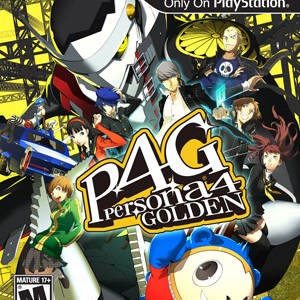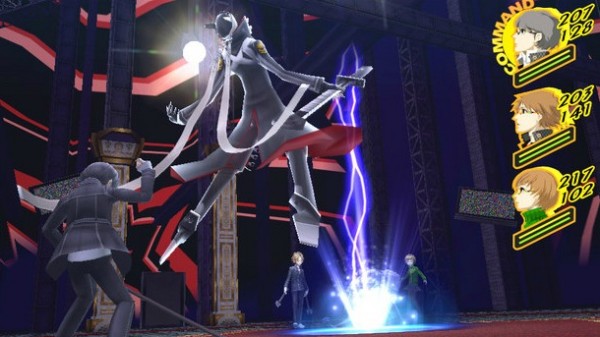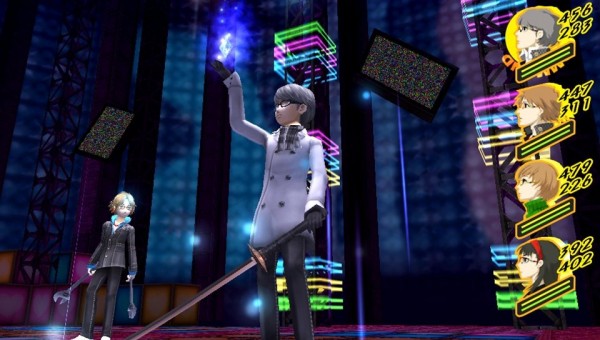There’s a certain craft to perfecting the expanded re-release. I’ve seen enough director’s cuts of films to know that some changes aren’t for the best. That problem isn’t as severe in the videogame medium, but there have been cases in which a game loses its appeal the second time around because of unnecessary bells and whistles. Persona 4 Golden is not one of those cases. Instead, it’s a shining beacon for the growing movement of videogame re-releases, incorporating smart, user-friendly changes and additional content that only makes the player’s time with an already-fantastic game more enjoyable.
Despite all of the changes that Persona 4 Golden introduces, it’s worth noting that this Vita edition was my first time spent with the original game. Persona 3 was a one-of-a-kind experience that improved significantly when I popped in the PSP version a few years later, so I channeled all of my patience in anticipation of similar treatment for Persona 4. I figure there are numerous players in the same boat as me, so rest assured that the mountain of praise for the original game is warranted. The characters are fantastic, the rural town of Inaba refreshing, and the writing is a brilliant mix of silly, emotional, and genuinely funny. Developer Atlus should also be commended for tackling complex social issues with the story, such as gender and sexual identity. By the time I finished the game (which clocked in at 70 hours), I truly felt sad that the compelling narrative had come to an end. There are few games that manage to instill that sense of emotional connection in me.
Persona 4 improves the dungeon-crawling aspect of its predecessor with direct control of allies and varied dungeons. Although I enjoyed my time with Persona 3, exploring Tartarus was often a tedious slog through identical floors that wore out its welcome far too soon. This time around, the variety in dungeon design is much improved and most of the environments are quite… unique. I have to say, this is the first time I’ve encountered a stripper pole in an RPG. Add in the same great battle system that rewards elemental strategies and you have one of the best JRPGs out there.
Newcomers like myself should look forward to a satisfying core experience, but Persona 4‘s greatness isn’t exactly news to the other half of this re-release’s target audience – the Persona faithful. That group is focused on meaningful changes and further content, and Atlus has delivered on both fronts. Two of the biggest additions come in the form of new social links: Marie, a mysterious girl who often spends time in the Velvet Room, and Adachi, the young detective who appeared in the original game. Marie is a solid addition to the colorful cast of characters with her ignorance of the outside world and introspective poems that always get misplaced in the Velvet Room. By the way, it’s worth maxing out Marie’s social link to see a brand new endgame dungeon.
The new social links don’t even scratch the surface of Persona 4 Golden‘s additional content. There’s a bug-catching mini-game, a garden to attend to, newly animated cutscenes, more holiday-themed trips, special outfits that can be worn in dungeons… the list goes on and on. Also included is additional voice work, though the original voice actors for Chie and Teddie could not be retained. Chie’s new voice actor is a bit more over-the-top and expressive, but I quickly got used to her. Teddie’s voice actor, on the other hand, sounds strikingly similar to the original. The staggering amount of additional content will, at the very least, keep Persona 4 fans busy. For what it’s worth, I found all of the additions worthwhile, especially the extended time following the “final” story conflict in the fictional December. Originally, the game skipped forward to March following that moment, but now players can continue to max out social links and even enjoy a ski trip in the months of January and February.
The additions even go on from there, such as a Dark Souls-esque online system in which players help out each other in dungeon battles with written messages and register what decisions they made during the day just by connecting to the internet. There’s probably more I’m missing simply because I didn’t play the original game. This must have been a labor of love on Atlus’ part.
I was even more impressed by the mechanical changes made in Persona 4 Golden. Two of the most critical are the fusion search function and the ability to choose which skills are inherited during the process. Quite a few hours are spent in the Velvet Room concocting different fusion combinations in an effort to create powerful monsters (personas) that aid the player in battle. This process is streamlined in the Vita version with the help of the search function. All possible personas that can be created at a given time are listed, meaning players are in and out of the Velvet Room without fumbling around in an effort to find that perfect combination. Even better is the fact that players can choose which skills are inherited during each fusion, an aspect that was originally left to chance.
Also included are skills cards that contain abilities for personas to inherit outside of the fusion process. These can be registered and then purchased later on, allowing the player even more creative control in crafting a persona exactly to their liking. One more change I appreciated was the card shuffle mechanic at the end of battles. Instead of carefully picking the desired card as they swirl around, the player is presented all of the cards without doing anything. Now there are even more cards to choose from with their own tempting benefits, such as increased experience and money. It does exclude the mini-game aspect of the original release, but when I’m in a huge dungeon I just want to get my reward and move on to the next battle.
Even though I’m new to Persona 4, I tried to imagine playing the game without these additions and it was tough. I loved choosing which skills to inherit during fusions and collecting skills cards. I enjoyed the story events in the months of January and February. I even liked planting tomato seedlings by the side of the house with Dojima and Nanako. Inevitably there will be purists of the original game who disagree, but I imagine that even fans of that 2008 release can appreciate the time and effort put in by Atlus to help make Persona 4 Golden the ultimate edition of this game.




















